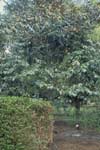Home >
Chrysophllum oliviforme, Satin Leaf
Satin Leaf should be grown in full sun or partial shade on fertile, well-drained soils. Plants should be mulched beneath the canopy and watered regularly until established, then they can withstand occasional drought. Unfortunately the tree has not been widely planted but should make a good, durable urban tree in USDA hardiness zones 10b and 11. Trunk and branch structure is quite durable provided trees receive some early training and pruning. Trees are tolerant of urban conditions and have performed well as street trees. Foliage is very attractive, especially in a breeze.
Clear all turf away from beneath the branches and mulch to the drip line, especially on young trees, to reduce competition with turf and weeds. This will allow roots to become well established and keep plants healthier. Prune the tree so trunks and branches will not rub each other. Remove some secondary branches on main branches with included bark. This reduces the likelihood of the main branch splitting from the tree later when it has grown to become an important part of the landscape. Locate the tree properly, taking into account the ultimate size, since the tree looks best if it is not pruned to control size. The tree can enhance any landscape with its delightful spring flush of foliage. It can be the centerpiece of your landscape if properly located.
Occurs from Sanibel to Stuart south to the Florida Keys. Plant is endangered in Florida.
National champion for this Florida native is 41 x 34 feet in Florida.



